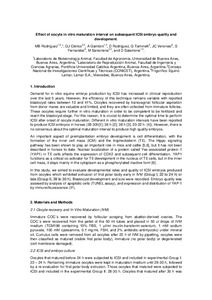Please use this identifier to cite or link to this item:
https://repositorio.uca.edu.ar/handle/123456789/9494| Título: | Effect of oocyte in vitro maturation interval on subsequent ICSI embryo quality and development | Autor: | Rodríguez, M. B. Clérico, Gabriel José Gambini, A. Rodríguez, D. Taminelli, Guillermo Veronesi, J. C. Fernández, S. Sansiñena, Marina Julia Salamone, D. |
Palabras clave: | FERTILIZACION IN VITRO; EQUINOS; OVOCITOS; DESARROLLO EMBRIONARIO | Fecha de publicación: | 2018 | Editorial: | Elsevier | Cita: | Rodríguez, M.B. et al. Effect of oocyte in vitro maturation interval on subsequent ICSI embryo quality and development [en línea]. Journal of Equine Veterinary Science. 2018, 66. doi:10.1016/j.jevs.2018.05.098 Disponible en: https://repositorio.uca.edu.ar/handle/123456789/9494 | Resumen: | Introduction: Demand for in vitro equine embryo production by ICSI has increased in clinical reproduction over the last 5 years. However, the efficiency of this technique remains variable with reported blastocyst rates between 10 and 41%. Oocytes recovered by transvaginal follicular aspiration from donor mares are valuable and limited, and they are often collected from immature follicles. These oocytes require further in vitro maturation in order to be competent to be fertilized and reach the blastocyst stage. For this reason, it is crucial to determine the optimal time to perform ICSI after onset of oocyte maturation. Different in vitro maturation intervals have been reported to produce ICSI embryos in horses (28-30h[1]; 36 h-[2]; 38 h [3]; 20-22 h- [4]). However, there is no consensus about the optimal maturation interval to produce high quality embryos. An important aspect of preimplantation embryo development is cell differentiation, with the formation of the inner cell mass (ICM) and the trophectoderm (TE). The Hippo signaling pathway has been shown to play an important role in mice and cattle [5,6], but it has not been described in horses to date. Nuclear localization of a protein called Yes-associated protein 1 (YAP1) in TE cells affects the expression of CDX2 and subsequent cell differentiation. YAP1 functions as a critical co-activator for TE development in the nucleus of TE cells, but in the inner cell mass, it stays mainly in the cytoplasm as a phosphorylated inactive form [6]. In this study, we aimed to evaluate developmental rates and quality of ICSI embryos produced from oocytes which exhibited extrusion of first polar body early in IVM (Group I, 22 to 24 h) or late (Group II, 28 to 30 h). Blastocyst development and size were recorded. Embryo quality was assesed by analysis of apoptotic cells (TUNEL assay), and expression and distribution of YAP-1 by immunoflourescence (IF). | URI: | https://repositorio.uca.edu.ar/handle/123456789/9494 | ISSN: | 0737-0806 | Disciplina: | CIENCIAS AGRARIAS | DOI: | 10.1016/j.jevs.2018.05.098 | Derechos: | Acceso abierto | Fuente: | Journal of Equine Veterinary Science. 2018, 66 |
| Appears in Collections: | Artículos |
Files in This Item:
| File | Description | Size | Format | |
|---|---|---|---|---|
| effect-oocyte-vitro-maturation.pdf | 406,03 kB | Adobe PDF |  View/Open |
Page view(s)
439
checked on Dec 8, 2025
Download(s)
276
checked on Dec 8, 2025
Google ScholarTM
Check
Altmetric
Altmetric
This item is licensed under a Creative Commons License

